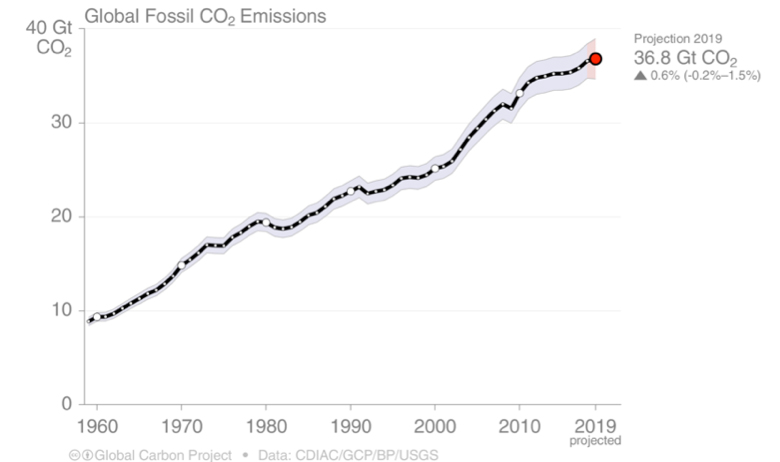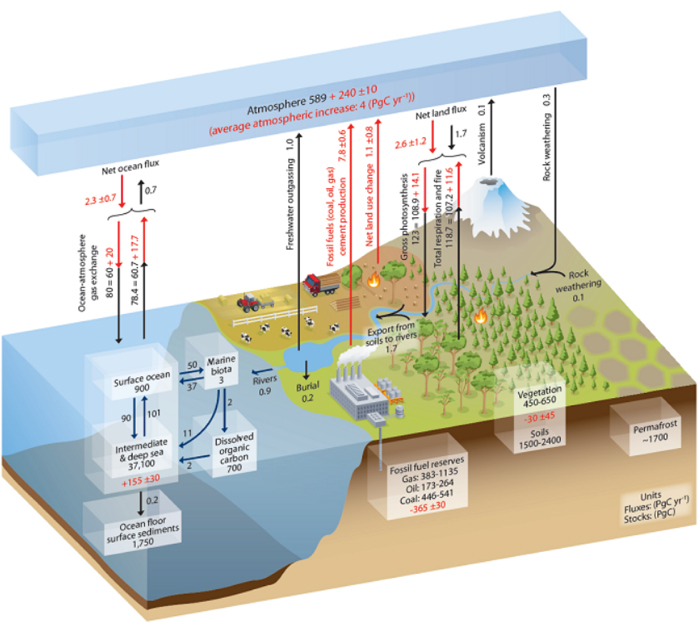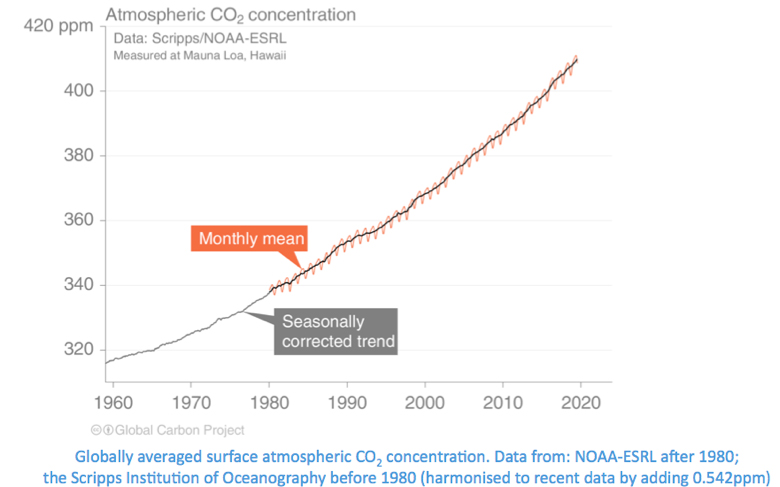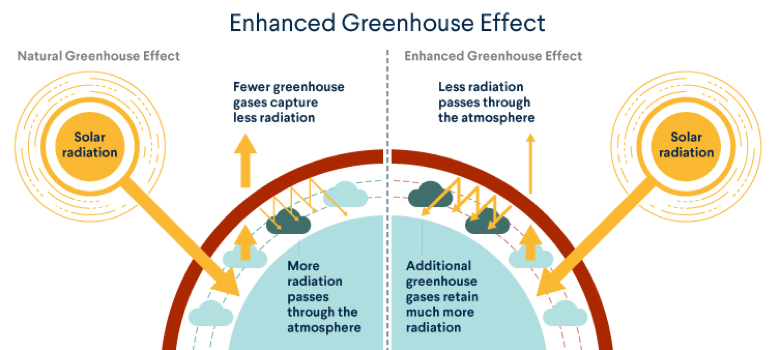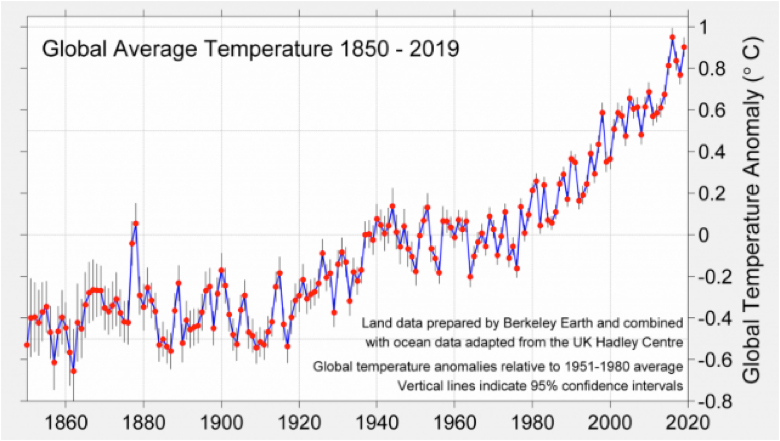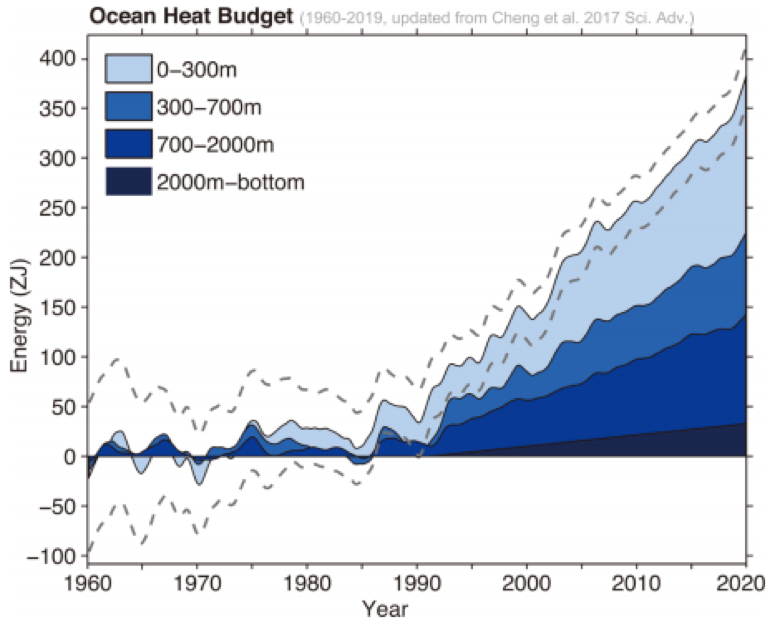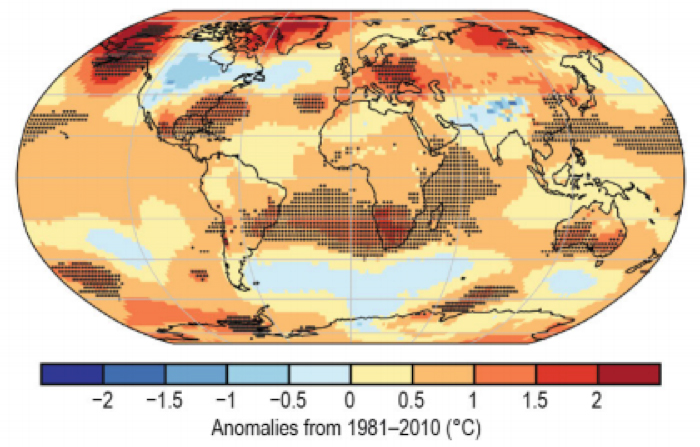In the midst of the COVID-19 pandemic, we are in the early stages of what could become an even more catastrophic global disaster—CLIMATE CHANGE. The Earth will become increasingly inhospitable to all forms of life in the 21st Century unless Climate Change is successfully mitigated (for details, access the information available in the Climate Change Impacts Section below). It is not too late to mitigate Climate Change successfully, but urgent and immediate action is needed. With vigorous advocacy, we can bring about the actions needed to protect the quality of life on Earth throughout the 21st Century.
Climate Change Mitigation
The Problem
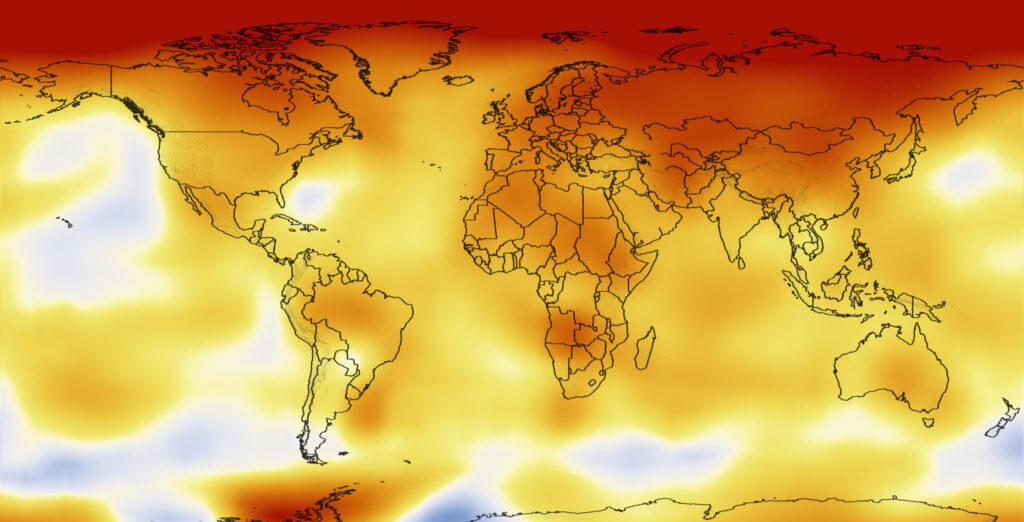
Our “[g]lobal climate is changing rapidly compared to the pace of natural variations in climate that have occurred throughout Earth’s history.”1 Global average temperature has increased by about 1.8°F (~1.0°C) from 1901 to 2016, and observational evidence does not support any credible natural explanations for this amount of warming; instead, the evidence consistently points to human activities, especially emissions of greenhouse or heat-trapping gases, as the dominant cause.”2
“Continued emission of greenhouse gases will cause further warming and long-lasting changes in all components of the climate system, increasing the likelihood of severe, pervasive and irreversible impacts for people and ecosystems.”3
The Solution
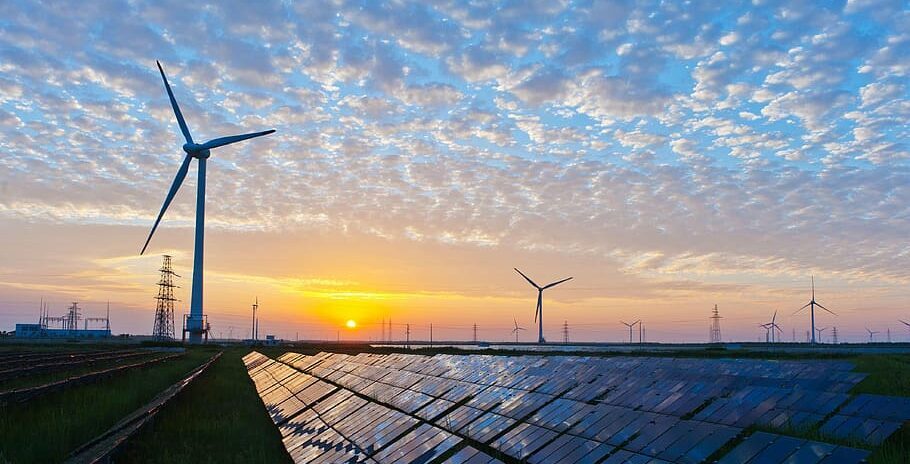
The most severe climate change impacts can be avoided only if the increase in global average temperature is limited to no more 1.5°C (2.7°F) above pre-industrial levels4. That is not possible without “reaching net-zero CO2 emissions globally around 2050.”5
“In the United States, most of the emissions of human-caused (anthropogenic) greenhouse gases (GHG) come primarily from burning fossil fuels—coal, hydrocarbon gas liquids, natural gas, and petroleum—for energy use.”6
“[C]arbon dioxide (CO2) emissions from burning fossil fuels for energy were equal to about 76 percent of total U.S. anthropogenic GHG emissions [in 2017] (based on global warming potential) and about 93 percent of total U.S. anthropogenic CO2 emissions.”7
So It's Clear:
Successful Climate Change Mitigation depends on achieving
the RF100 Energy Goals of:
the RF100 Energy Goals of:
• All electricity being generated from clean renewable sources by 2035;
• All energy used for every purpose being provided by clean renewable sources by
2050.
Climate Change Impacts
Introduction
Below we provide detailed information about some dramatic Climate Change impacts that have been occurring with increasing frequency and will, if not mitigated successfully, become increasingly frequent and severe. We have organized these impacts under 5 interrelated topics:
Climate Change is a very complex phenomenon with a lot of “moving parts.” We present this information in ways we hope will make it easier to access and comprehend than it often is when presented in more technical formats. Accordingly, our presentation features illustrative graphics accompanied by short narratives, and, for those who want to get into the Climate Change “weeds,” some downloadable materials that provide a lot of details. Accordingly, our presentation features illustrative graphics accompanied by short narratives, and, for those who want to get into the Climate Change “weeds,” some downloadable materials that provide a lot of details.
- Disrupted Carbon Cycles
- Global Warming
- De-Icing, Seas Rising (Stay tuned)
- Volitile Weather (Stay tuned)
- Endangered Biosphere (Stay tuned)
Climate Change is a very complex phenomenon with a lot of “moving parts.” We present this information in ways we hope will make it easier to access and comprehend than it often is when presented in more technical formats. Accordingly, our presentation features illustrative graphics accompanied by short narratives, and, for those who want to get into the Climate Change “weeds,” some downloadable materials that provide a lot of details. Accordingly, our presentation features illustrative graphics accompanied by short narratives, and, for those who want to get into the Climate Change “weeds,” some downloadable materials that provide a lot of details.
Disrupted Carbon Cycles
Increasing CO2 Emmissions from Human Activities
“Global fossil CO2 emissions have risen steadily over the last decades & show no sign of peaking. Fossil CO2 emissions will likely be 62 percent higher in 2019 than . . . in 1990.”8
Disrupted Carbon Cycles9
The Earth’s carbon is stored in various reservoirs, including the atmosphere, the ocean (solubilized carbon and carbon in biomass), land plants, soil, fossil carbon (including coal, oil, natural gas), and carbonate sedimentary rocks (limestone & magnesia MgCO3).10 Carbon flows among these reservoirs in two cycles. There is a short (fast) cycle in which carbon CO2 is extracted from the atmosphere “by plants, algae and certain bacteria . . .” [through] photosynthesis and then is released “back to the atmosphere” by the “respiration and decomposition of living beings.”11 “[T]here is a slow geological cycle that stores carbon in the form of limestone and fossil hydrocarbons. Limestone comes from the shells of marine organisms while hydrocarbons are formed by burial of organic sediments. The combustion of fossil resources currently represents a short circuit from this slow cycle to the short (fast) cycle that largely dominates natural regeneration processes. This leads to a rapid accumulation of CO2 in the atmosphere, causing global warming, and ocean acidification . . ..”12 In absence of the combustion of fossil resources, the carbon cycles kept CO2 concentrations stable.13 The red lines and numbers show how the Carbon Cycles have been disrupted by human use of fossil energy.14
Increasing Atmospheric CO2 Concentration
“The global CO2 concentration increased from ~277 ppm in 1750 to 407 ppm in 2018 (up 46 percent)[, and] 2016 was the first full year with concentration above 400 ppm.”33
Rising Ocean Acidification
Increases in atmospheric CO2 concentration, seawater CO2 concentration, and seawater acidification (a decline in seawater PH) are significantly interrelated. “The upper panel shows the linked increase in atmospheric (red points) and seawater (blue points) CO2 concentrations. The bottom panel shows a decline in seawater pH (black points, primary y-axis) and carbonate ion concentration (green points, secondary y-axis).”42
Global Warming
Enhanced Greenhouse Gas Effect
“The greenhouse effect is a natural process responsible for keeping the earth at the temperature needed to sustain life. Acting just like the glass walls of a greenhouse, gases like carbon dioxide, methane, and nitrous oxide trap the sun’s heat in the atmosphere and prevent it from escaping into space. . . . Normally, the greenhouse effect keeps the earth just warm enough to sustain life. Scientists say that without the greenhouse effect, the average temperature of the earth would drop from 14˚C (57˚F) to as low as −18˚C (−0.4˚F). Today, however, the greenhouse effect is growing stronger as human activities such as deforestation and fossil fuel use release more and more greenhouse gases into the atmosphere. This traps greater amounts of the sun’s radiation, which contributes to rising temperatures, also known as global warming.”48
Rising Surface Temperature
“2019 was the second warmest year on Earth since 1850. The global mean temperature in 2019 was colder than 2016, but warmer than every other year that has been directly measured. Consequently, 2016 remains the warmest year in the period of historical observations. Year-to-year rankings are likely to reflect short-term natural variability, but the overall pattern remains consistent with a long-term trend towards global warming.”68 “The global mean temperature in 2019 was estimated to be 1.28 °C (2.31 °F) above the average temperature of the late 19th century, from 1850-1900, a period often used as a pre-industrial baseline for global temperature targets.”69
Ocean Heating
”Human-emitted greenhouse gases (GHGs) have resulted in a long-term and unequivocal warming of the planet . . .. More than 90% of the excess heat is stored within the world’s oceans, where it accumulates and causes increases in ocean temperature . . .. Because the oceans are the main repository of the Earth’s energy imbalance, measuring ocean heat content (OHC) is one of the best ways to quantify the rate of global warming.”75 The above graphic is a “Revised Ocean Energy Budget.”76 “The new results indicate a total full-depth
ocean warming of 370 ± 81 ZJ (equal to a net heating of 0.38 ± 0.08 W m−2 over the global surface) from 1960 to 2019, with contributions of 41.0%, 21.5%, 28.6% and 8.9% from the 0–300-m, 300–700-m, 700–2000-m, and below-2000-m layers, respectively.”77 Note, ZJ = Zetta Joules, and 1 ZJ = 1021 Joules.78
Rising Tropospheric Temperature
This graphic,87 “provided by the European Centre for Medium-Range Forecasts Reanalysis version 5 (ERA5),”88 [shows] “the spatial details of the departures of LLT (Lower Troposphere Temperature) from the 1981–2010 mean . . ..”89 “Above-average anomalies dominate the 2019 ERA5 map with negative regions occupying only 8.1% of the global surface area, including much of North America, a portion of South Asia, and mid-latitude regions of the southern oceans. These below-average LTTs comprise the third-smallest such area after 2016 and 2017.”90 “Much higher-than-average temperatures included several regions that experienced record high temperatures relative to this 41-year period of observations. Alaska, Greenland, central Europe, and southern Africa were especially warm.”91 The areas experience record highs are indicated by the brown cross-hatchings.92 (Note, the lower troposphere “encompasses the atmosphere from the surface to an average height of ~10 km.”).93
